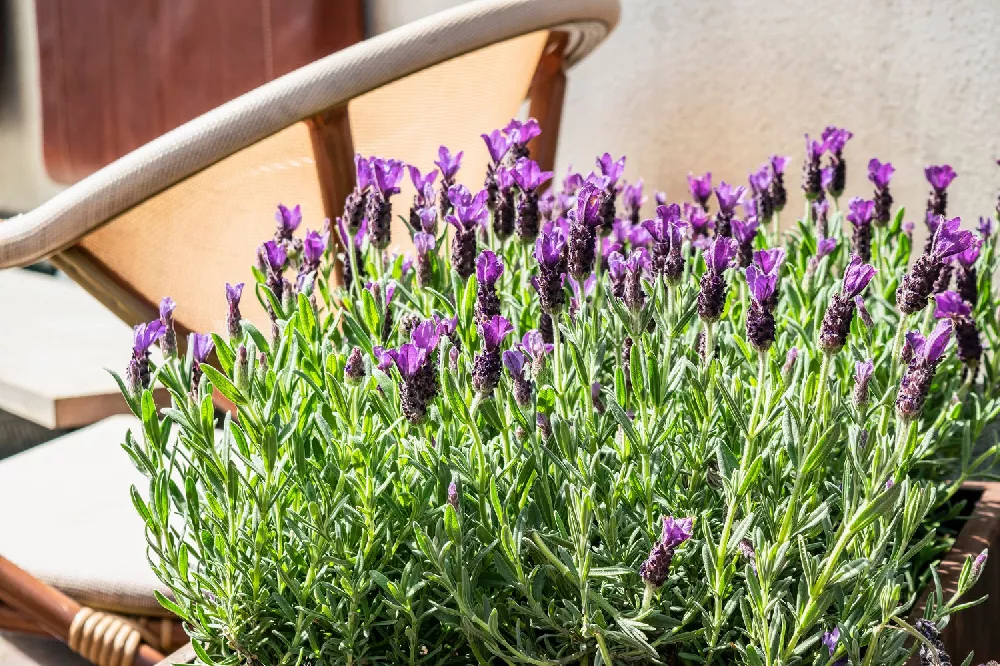Lavender Standard Topiary Trees for Sale
Few plants are both tough as nails and also lovely all summer long — but Lavandula stoechas 'Anouk' has no problem with either of these desirable traits. Like all lavenders, it is drought-resistant and in fact grows better in poor soil. It is deer-resistant but a magnet to pollinators like honeybees. It looks attractive in either formal gardens or more casual cottage gardens, and it is elegant when grown in a container. It flowers for much of the summer, with attractive blooms that can be harvested for potpourri or sachets. Here are a few more reasons why you need a lavender standard topiary tree:
- Flowers dry easily and can be used in dried flower arrangements, and they also have culinary uses.
- Fragrant flowers and leaves perfume your whole garden.
- Stays evergreen in warmer climates.
Enter your zip code to find nearby stores that may carry this plant.
Plant Care
Sunlight

Sun-loving lavender does best when it receives full sun. Aim for six to eight hours of direct light a day.
Watering
For its first season, water your lavender standard topiary tree weekly. After that, it shouldn't need supplemental watering.
Fertilizing

Fertilize in spring with a light application of a slow-release all-purpose fertilizer; use less than the package recommends.
Planting and Care
Planting instructions
Choose a site for your lavender standard topiary tree that receives full sun. Lavender grows well in soil that is sandy or light; if your soil is heavy or drains poorly, mix some sand into the area where you’re planting. Dig a hole that’s twice as wide and as deep as the plant’s root ball. Unpot the topiary and tease out any encircling roots, as they can girdle the tree and kill it slowly. Place the topiary in the hole, keeping it upright while you fill in dirt around it, tamping it down as you go. Water thoroughly. Mulching around the tree with an organic mulch, such as bark chips, can help conserve moisture so you won’t have to water as much.
Watering and nutrients
For its first year, water your lavender standard topiary tree about once a week, giving it roughly an inch of water at a time. Once it is established and growing strongly, you can cut back on supplemental watering. Lavender is tolerant of drought and dry soil, and there’s no need to give your topiary tree extra water unless it starts drooping or leaves start turning brown. Fertilize your lavender standard topiary tree with a very light hand: the plants thrive on neglect and don’t require much in the way of added nutrients. A scant application of a balanced, slow-release product once a year in spring is more than enough for these tough plants.
Pollination
Lavender plants are pollinator magnets for bees and butterflies, which are drawn to the fragrant purple/pink flowers. The flowers have both stamens and a pistil, so they are easily pollinated by insects. The plants can also be reproduced through cuttings taken off the plants and placed in a growing medium, or by dividing the plants.
Pruning
You will want to prune your lavender standard topiary tree regularly to keep its tidy shape intact. Trim off spent flowers to help encourage new blooms throughout the summer as needed. In late summer, do a more thorough pruning for shape, trimming back any branches that stray from the tree’s shape. Be careful not to cut them back too hard, however, as this can kill them.
Pests and diseases
Lavender plants are not susceptible to many diseases. Root rot, phytophthora, may cause wilting or yellow leaves and is sometimes found in soil that is overly wet or waterlogged. Avoid watering your mature plant unless the soil is parched, and be sure to choose a site for your lavender standard topiary tree that drains well.
Pests that may bother your lavender plants include spittlebugs, whiteflies, and aphids. Organic insecticides may be useful, and it is helpful to encourage beneficial insects such as ladybugs that prey on aphids and other pests.
Harvesting
Lavender can be used in tea and as an herb in cooking, and the fragrant leaves and flowers may also be used for crafts. Harvest the flowers when they are just starting to open. Gather a group together, tie it with twine, and hang it upside down in a cool, dark place for several weeks to dry. Conversely, you can dry leaves and flowers in a dehydrator or in your oven on a very low setting.
Achieving maximum results
Achieving maximum results with a lavender standard topiary tree isn’t difficult, if you start off on the right foot by placing the tree in a site where it gets good sun and drainage. If planting in a container, mix some sand in with the potting soil, and make sure there are holes in the bottom of the pot so water can drain through quickly. Lavender standards topiary trees are a moderate size, maxing out at 2 to 3 feet, so they make great patio plants. They can stay outside if you are in USDA hardiness zone 7 or above. Those in more northern climates should bring your lavender topiary trees inside in the winter, placing them in a sunny window and watering infrequently.
FAQs
How can I be sure my lavender won't get too much water?
There are a few precautions you can take to ensure that you're providing your lavender with the dry conditions that it loves. Planting in a raised bed with good drainage can help, as can planting it alongside a walkway, driveway, or other structure that retains heat and can contribute to drier conditions. If you use drip irrigation, place the emitter a few inches away from the plant, so that it's not right above the root ball.
Is lavender an easy plant to grow?
Lavender is an excellent choice for beginning gardeners or anyone who wants a plant that thrives on neglect. If you site your lavender carefully and nurture it during its first year, it should reward you with years of garden loveliness. Since it is attractive to pollinators, it's an excellent plant to grow for those who also have fruit trees or a vegetable garden because it will draw pollinating insects to your property, thus increasing your yield of produce.
How long does lavender live?
Lavender is a short-lived perennial and should provide robust healthy flowers for five to seven years. The best way to ensure a long life for your lavender is to give it conditions that are similar to the dry Mediterranean climate where it grows wild.
Compare Similar Products
You can't add more Product Name - Product size to the cart.
OK











